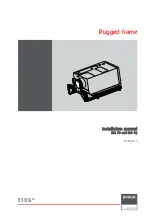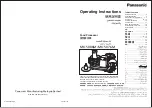
3-10
OPERATION
ORBAN MODEL 8300
Input/Output Delay
The algorithmic improvements in the 8300 over earlier generations of Orban DSP-
based processing (8200 and 2200) have one significant cost — the input/output time
delay is typically 15 ms. To make intelligent decisions about how to process, the 8300
needs to look ahead at the next part of the program waveform. As digital on-air
processing advances further and further from its analog roots, this is the inevitable
price of progress.
15 ms is comfortably below the psychoacoustic “echo fusion threshold,” which
means that talent will not hear discrete slap echoes in their headphones. This means
that they can monitor comfortably off-air without being distracted or confused.
Some talent moving from an analog processing chain will require a learning period
to become accustomed to the voice coloration caused by “bone-conduction” comb
filtering. This is caused by the delayed headphone sound’s mixing with the live voice
sound, which introduces notches in the spectrum that the talent hears when he or
she talks. All digital processors induce this coloration to a greater or lesser extent.
Fortunately, it does not cause confusion or hesitation in the talent’s performance
unless the delay is above the psychoacoustic “echo fusion” (Haas) threshold of ap-
proximately 20 ms, where the talent starts to hear slap echo in addition to fre-
quency response colorations.
If talent cannot live with 15 ms delay yet needs to monitor off-air, you can use one
of several ultra-low latency (“UL”) presets, which have 5 ms delay. These provide a
poorer tradeoff between loudness, brightness, and distortion than the optimum la-
tency presets because they do not use the 8300’s intelligent look-ahead distortion
control mechanism. We therefore recommend their use only when necessary.
If the talent is in the same location as the 8300, you can configure the 8300’s analog
outputs to supply a special low-latency monitor signal to drive headphones only.
(See step 10 on page 2-18.)
Customizing the 8300’s Sound
The subjective setup controls on the 8300 give you the flexibility to customize your
station’s sound. Nevertheless, as with any audio processing system, proper adjust-
ment of these controls consists of balancing the trade-offs between loudness, den-
sity, and audible distortion. The following pages provide the information you need
to adjust the 8300 controls to suit your format, taste, and competitive situation.
When you start with one of our Factory Presets, there are two levels of subjective
adjustment available to you to let you customize the Factory Preset to your re-
quirements: Basic Modify and Full Modify. A third level,
Advanced Modify
, is accessi-
ble
only from the 8300’s PC Remote software
.
See page 6-62 for a block diagram of the processing.
Summary of Contents for 8300J
Page 1: ...Operating Manual OPTIMOD FM 8300 Digital Audio Processor Version 2 1 Software...
Page 7: ...Operating Manual OPTIMOD FM 8300 Digital Audio Processor Version 2 1 Software...
Page 24: ......
Page 94: ...2 46 INSTALLATION ORBAN MODEL 8300 This page intentionally left blank...
Page 190: ......
Page 204: ......
Page 246: ......
Page 247: ...OPTIMOD FM DIGITAL TECHNICAL DATA 6 29...
Page 254: ...6 36 TECHNICAL DATA ORBAN MODEL 8300 CPU Module...
Page 260: ...6 42 TECHNICAL DATA ORBAN MODEL 8300 8300 RS232 BOARD PARTS LOCATOR...
Page 262: ...6 44 TECHNICAL DATA ORBAN MODEL 8300 8300 POWER SUPPLY PARTS LOCATOR...
Page 264: ...6 46 TECHNICAL DATA ORBAN MODEL 8300 8300 I O BOARD PARTS LOCATOR...
Page 270: ...6 52 TECHNICAL DATA ORBAN MODEL 8300 DSP BOARD PARTS LOCATOR DRAWING 32170 000 14...
Page 278: ...6 60 TECHNICAL DATA ORBAN MODEL 8300 8300 DISPLAY BOARD PARTS LOCATOR...
Page 279: ...OPTIMOD FM DIGITAL TECHNICAL DATA 6 61 DISPLAY BOARD...
















































